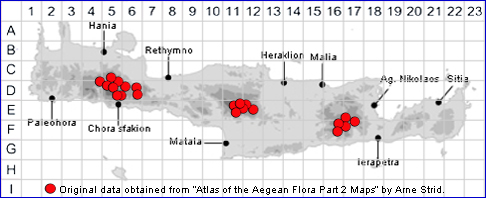
SPECIES DESCRIPTION
LOMELOSIA SPHACIOTICA
Most plants from Lefka Ori, subsp. sphaciotica, have densely white-lanate to
white-sericeous leaves, whereas plants from Psiloritis and Dikti, subsp. decalvans
are sparsely pubescent and green.
Occasional intermediates occur, but usually the two geographical races are easily
identified on leaf indumentum.1)
1) Arne Strid "Atlas of the Aegean Flora". Book 1, 2016
Family and Genus:- See- DIPSACACEAE/Sect. TROCHOCEPHALUS
Common Names:- None
Homotypic Synonyms:- Asterocephalus sphacioticus, Scabiosa sphaciotica,
Trochocephalus sphaciotia.
Meaning:- Lomelosia. Meaning unknown.
Sphaciotica (Gr) Damaged-looking.
General description:- Tufted perennial, woody at the base.
Stems:-
1) 3-10 cm, slender, leafless or with 1 pair of leaves at the base.
Leaves:-
1) Up to 20 x c. 5 mm, linear or linear-lanceolate, pinnatifid, densely white lanate or
green and densely hirsute.
Flower:-
1) Capitula, 10-15 mm diam., solitary, with c. 8(-13) florets.
2) Involucral bracts, 4-5 mm, c. 2/3 as long as florets, ovate-lanceolate, obtuse,
densely white-pubescent.
3) Involucel-tube, c. 1·5 mm; pits c. 0·6 mm.
4) Corona, with 25-30 veins.
5) Calyx setae, about twice as long as the corona.
6) Corolla, marginal florets 6-10 mm, distinctly longer than that of the central florets,
lilac-pink.
7) Anthers, c. 1·5 mm.
Key features:-
1) Stem, woody at the base.
2) Upper leaves, pinnatifid.
3) Involucel-tube, less than 2 mm.
4) Capitulum, 10-15 mm diam.
Habitat:- Rocky and stony slopes and flats, stabilised limestone screes. (1100-)
1600-2300 m.
Distribution:- Endemic Lefka Ori, Psiloritis and Dikti. Rare.
Flowering time:- Late June to early Sept.
Photos by:- Philippa Dean
